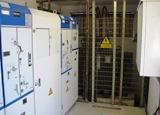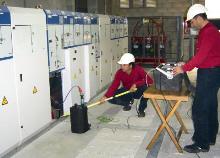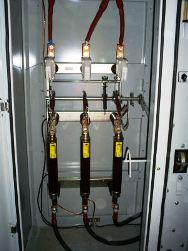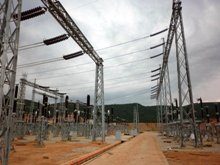Switchgear over 1000 V
 Distribution equipment includes circuit breakers, disconnectors, fuses, current and voltage measuring transformers, arresters, reactors, bus system, power cables, etc.
Distribution equipment includes circuit breakers, disconnectors, fuses, current and voltage measuring transformers, arresters, reactors, bus system, power cables, etc.
All switchgear equipment above 1000 V is selected on the basis of: continuous operation at rated currents, short-term overloads, short-circuit currents and significant voltage increases associated with atmospheric or internal overvoltages (for example, when a phase-to-earth fault occurs by arcing, the inclusion on long open lines, etc.).
Live parts in normal mode, when thermal equilibrium is established (ie, when the heat released by the live part during the flow of the rated current is equal to the amount of heat released from the conductor to the environment), should not heats up above the maximum permissible temperatures: 70 ° C — for bare (uninsulated) tires and 75 ° C — for removable and fixed connections of tires and devices.
 It is forbidden to continuously exceed the temperature of live parts above the permissible norms... This regime leads to an increase in the transient resistance in the connections of the current-carrying parts of the equipment, which in turn leads to an additional increase in the temperature of the contact connection with a subsequent increase in the transient resistance in her etc.
It is forbidden to continuously exceed the temperature of live parts above the permissible norms... This regime leads to an increase in the transient resistance in the connections of the current-carrying parts of the equipment, which in turn leads to an additional increase in the temperature of the contact connection with a subsequent increase in the transient resistance in her etc.
As a result of this process, the contact connection of the current-carrying part is destroyed and an open arc occurs, which, as a rule, leads to a short circuit and an emergency exit from the operation of the equipment.
The flow of short-circuit currents through busbars or devices is accompanied by:
a) additional release of heat through live parts through which short-circuit currents flow (the so-called thermal action of short-circuit currents),
b) significant mechanical forces of attraction or repulsion between conductors of adjacent phases or even of the same phase, for example near a reactor (so-called electrodynamic effects between live parts).
 Switchgear must be thermally stable… This means that with possible magnitudes and durations of short-circuit currents, the resulting short-term rise in temperature of live parts must not cause equipment damage.
Switchgear must be thermally stable… This means that with possible magnitudes and durations of short-circuit currents, the resulting short-term rise in temperature of live parts must not cause equipment damage.
Short-term temperature rises are limited: for copper busbars 300 ° C, for aluminum buses 200 ° C, for cables with copper conductors 250 ° C, etc. After the short circuit is removed by relay protection, the wires are cooled to a temperature corresponding to a steady state.
Apparatus and busbars must be dynamically resistant to short-circuit currents... This means that they must withstand the dynamic forces caused by the passage through them of the largest (shock) short-circuit current corresponding to the initial moment of occurrence of the short-circuit current possible in the given switchgear.
Therefore, switchgear must be selected in such a way, and busbars must be designed, that their thermal and dynamic resistance to short-circuit currents is greater than or corresponds to such maximum short-circuit current values, which are possible in the given switchgear.
To limit the magnitude of short-circuit currents, apply reactors... A reactor is a coil without a steel core with high inductive resistance and low resistance.
Therefore, the power loss in the reactor is usually no more than 0.2-0.3% of its throughput. Therefore, under normal conditions, the reactor has almost no effect on the flow of active power through it (its voltage loss is negligible).
In the event of a short circuit, the reactor limits the magnitude of the short circuit current in the circuit due to its significant inductive resistance. In addition, in the event of a short circuit after the reactor, the voltage in the busbars is maintained due to the large voltage drop in it, which provides other consumers with the opportunity to continue uninterrupted operation.
The reactor installed on the link allows you to select the devices installed behind the reactor (current transformers, disconnectors, circuit breakers) and, what is especially important, the devices and cables of the distribution network behind the line, designed for lower thermal and dynamic actions of currents of short circuit, which greatly simplifies the design and reduces the cost of electrical distribution equipment.
 The insulation class of the electrical equipment must not be lower than the rated voltage of the network... The protection level of the surge protection devices must correspond to the insulation level of the electrical equipment.
The insulation class of the electrical equipment must not be lower than the rated voltage of the network... The protection level of the surge protection devices must correspond to the insulation level of the electrical equipment.
When the switchgear is located in areas where the air contains substances that have a destructive effect on the equipment or reduce the level of insulation, measures must be taken to ensure reliable operation of the installation.
The insulation of electrical devices must ensure their reliable operation at three nominal voltages for which these devices are designed, as well as at the maximum permissible continuous voltage during operation and at possible overvoltages.
Electrical switchgear (high voltage circuit breakers, disconnectors etc.) are produced for nominal voltages that correspond to the accepted nominal voltages of electrical networks.
It is unacceptable to install devices designed for a lower nominal voltage in networks with a high nominal voltage, because in the event of an overvoltage they can be blocked, which will lead to an emergency shutdown of the equipment.Therefore, the nominal voltage of the equipment must correspond to the nominal voltage of the network to which this equipment is connected.
Equipment designed for operation in closed switchgear cannot be used in open installations without special measures, as this equipment does not provide the required degree of reliability for these conditions.
Due to the fact that atmospheric overvoltage usually plays a decisive role in the selection of insulation level, the insulation level or class of a given rated voltage is usually characterized by a pulse test voltage.
On the lines, the limitation of the impulse voltage under operating conditions must be ensured by protective devices (cable and arresters). Protection of the insulation of electrical equipment installed in the substation from impulse voltage waves passing from the line to the substation buses must be carried out. valve restrictors.
The characteristics of these arresters must also match the insulation level of the electrical equipment, so that in the event of a surge, the arresters will trip and discharge charges to ground at impulse voltages lower than those that could damage the insulation of the the distribution equipment (insulation coordination).
